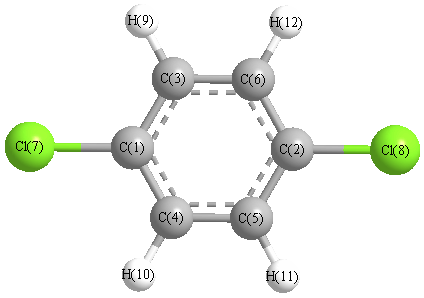Vibrational levels (cm-1) 
| Mode Number |
Symmetry |
Frequency |
Intensity |
Comment |
Description |
| Fundamental(cm-1) |
Harmonic(cm-1) |
Reference |
(km mol-1) |
unc. |
Reference |
| 1 |
Ag |
3072 |
|
1970Gre:1503 |
|
|
|
1 |
|
| 2 |
Ag |
1574 |
|
|
|
|
|
2 |
|
| 3 |
Ag |
1169 |
|
|
|
|
|
3 |
|
| 4 |
Ag |
1096 |
|
|
|
|
|
4 |
|
| 5 |
Ag |
747 |
|
|
|
|
|
5 |
|
| 6 |
Ag |
328 |
|
|
|
|
|
6 |
|
| 7 |
Au |
951 |
|
|
|
|
|
16 |
|
| 8 |
Au |
405 |
|
|
|
|
|
17 |
|
| 9 |
B1g |
815 |
|
|
|
|
|
7 |
|
| 10 |
B1u |
3078 |
|
|
|
|
|
18 |
|
| 11 |
B1u |
1477 |
|
|
|
|
|
19 |
|
| 12 |
B1u |
1090 |
|
|
|
|
|
20 |
|
| 13 |
B1u |
1015 |
|
|
|
|
|
21 |
|
| 14 |
B1u |
550 |
|
|
|
|
|
22 |
|
| 15 |
B2g |
934 |
|
|
|
|
|
8 |
|
| 16 |
B2g |
687 |
|
|
|
|
|
9 |
|
| 17 |
B2g |
298 |
|
|
|
|
|
10 |
|
| 18 |
B2u |
3087 |
|
|
|
|
|
23 |
|
| 19 |
B2u |
1394 |
|
|
|
|
|
24 |
|
| 20 |
B2u |
1220 |
|
|
|
|
|
25 |
|
| 21 |
B2u |
1107 |
|
|
|
|
|
26 |
|
| 22 |
B2u |
226 |
|
|
|
|
|
27 |
|
| 23 |
B3g |
3065 |
|
|
|
|
|
11 |
|
| 24 |
B3g |
1574 |
|
|
|
|
|
12 |
|
| 25 |
B3g |
1290 |
|
|
|
|
|
13 |
|
| 26 |
B3g |
626 |
|
|
|
|
|
14 |
|
| 27 |
B3g |
350 |
|
|
|
|
|
15 |
|
| 28 |
B3u |
819 |
|
|
|
|
|
28 |
|
| 29 |
B3u |
485 |
|
|
|
|
|
29 |
|
| 30 |
B3u |
122 |
|
|
|
|
|
30 |
|
vibrational zero-point energy: 17325.5 cm
-1 (from fundamental vibrations)
Calculated vibrational frequencies for
C
6H
4Cl
2 (1,4-dichlorobenzene).
Gas-phase IR spectra can be found in the NIST Chemistry Webbook
here.
Geometric Data

Point Group D2h
Internal coordinates
distances (r) in Å, angles (a) in degrees, dihedrals (d) in degrees
These cartesians were determined using some assumed coordinate values.
Cartesians
Atom - Atom Distances 
Distances in Å
Calculated geometries
for C
6H
4Cl
2 (1,4-dichlorobenzene).
Bond descriptions
Examples: C-C single bond, C=C, double bond, C#C triple bond, C:C aromatic bond
| Bond Type |
Count |
| C:C |
6 |
| H-C |
4 |
| C-Cl |
2 |
Connectivity
| Atom 1 |
Atom 2 |
| C1 |
C3 |
| C1 |
C4 |
| C1 |
Cl7 |
| C2 |
C5 |
| C2 |
C6 |
| C2 |
Cl8 |
| C3 |
C6 |
| C3 |
H9 |
| C4 |
C5 |
| C4 |
H10 |
| C5 |
H11 |
| C6 |
H12 |









